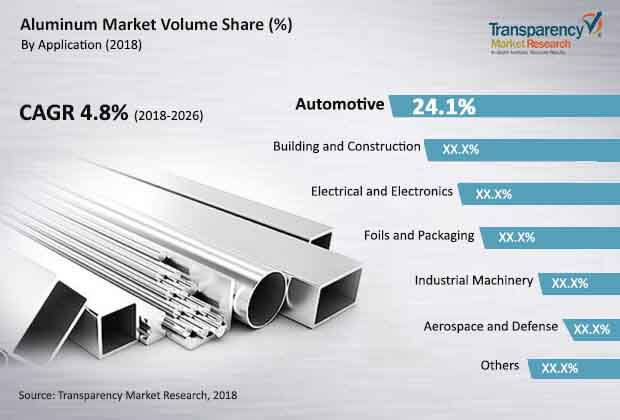Aluminum Market is Set to Reach US$ 303.53 Bn by 2026
The global aluminum market displays a highly consolidated vendor landscape with a handful of large players holding key share, states Transparency Market Research (TMR) in a new market study. Due to high price sensitivity of aluminum alloys, price wars are seen among existing manufacturers. This, in turn intensifies competition among players in the aluminum market.
Top players in the global aluminum market include Norsk Hydro ASA, Alcoa Corporation, Aluminum Corporation of China Limited, Emirates Global Aluminum PJSC, RUSAL, and Rio Tinto.
According to findings of the TMR report, the global aluminum market is predicted to display a healthy 5.6% CAGR between 2018 and 2026, for the market to be worth US$303.53 bn by 2026. The market stood at a valuation of US$188.24 bn in 2017.
Request A Sample Of Aluminum Market -
https://www.transparencymarketresearch.com/sample/sample.php?flag=S&rep_id=48957
On the basis of application, automotive is the key application segment of the aluminum market. With the exponential growth of the automotive industry post the economic recession of 2007, the aluminum industry is witnessing boost. This is because aluminum alloys are extensively used in the manufacture of automotive components. Geography-wise, Asia Pacific stood as the leading regional market for aluminum in 2017. Growth of the electronics industry in the region is a key factor behind the growth of aluminum industry in Asia Pacific.

Desire for Lightweight Automotive Components to enhance Vehicle Efficiency spurs Growth
Exponential growth of the automotive industry is a key factor driving the global aluminum market. With a spurt of technological and mechanical advancements in automotive that requires light-weight body, the future of the aluminum industry is bright. Players in the aluminum market are making efforts to develop lightweight aluminum alloys that fulfill these requirements.
For More Information, Request Brochure@
https://www.transparencymarketresearch.com/sample/sample.php?flag=B&rep_id=48957
Aluminum alloys in automotive present other advantages too. Mechanically, resistance experienced by vehicles impacts fuel consumption and CO2 emissions. As a rule of thumb, higher resistance results into greater thrust to move the vehicle resulting in increased CO2 emissions. Vehicle performance parameters such as rolling, acceleration resistance, and gradient are highly dependent on vehicle weight. Lightweight design of vehicles that employs lightweight materials such as aluminum can help lower CO2 emissions in automobiles.
Due to such tangible benefits, the use of aluminum in automobiles is likely to surge to a high degree. The use of aluminum body sheets is likely to rise by 110% over the next 10 years.